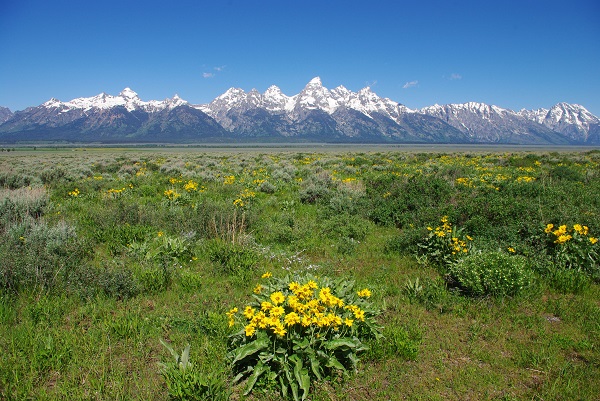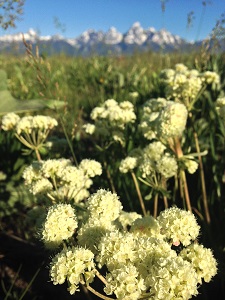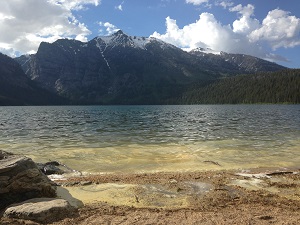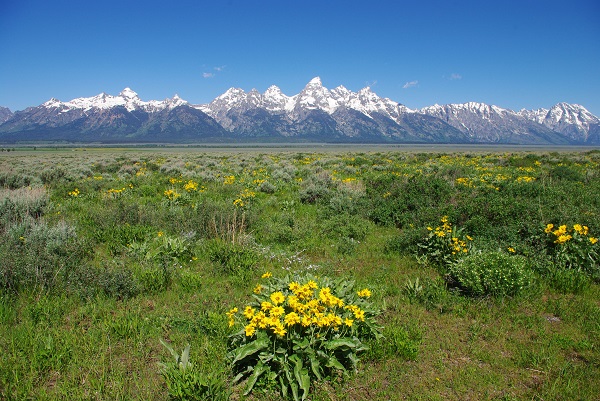
As summer builds steadily in the Tetons, new constellations of wildflowers appear throughout the valley. I watch daily as these arrivals add depth to the color palette of sagebrush flats, grassy buttes, boggy meadows, and creek banks. There is something marvelous about observing these kinds of phenological shifts, as if the seasonality of the natural world can be measured in gradients of growth and color. And this time of year, that pace of change accelerates as days lengthen and linger.
 I take a walk one evening along Ditch Creek and recall the sheer delight of glimpsing the first yellow flowers of early spring some months ago: desert parsley, sage buttercup, yellowbells. Now, as Summer Solstice marks the longest day of the year, those delicate yellows have been replaced with the brighter hues of groundsel, hawksbeard, and arnica. As I scan the sagebrush horizon, balsamroot (above) is still the dominant yellow but it, too, is beginning to fade, its petals curling at the edges. Scarlet gilia has been in bloom for weeks now, and I notice its trumpet-like flowers begin to elongate as they prepare for their annual transition towards seed. Other vestiges of spring wildflowers are still evident: the flower stalks of sitka valerian that once blossomed white are now podded green, while the bluish-purple heads of phacelia appear brown and flattened against the earth. I scan my surroundings for traces of Nelson’s larkspur, but spot none.
I take a walk one evening along Ditch Creek and recall the sheer delight of glimpsing the first yellow flowers of early spring some months ago: desert parsley, sage buttercup, yellowbells. Now, as Summer Solstice marks the longest day of the year, those delicate yellows have been replaced with the brighter hues of groundsel, hawksbeard, and arnica. As I scan the sagebrush horizon, balsamroot (above) is still the dominant yellow but it, too, is beginning to fade, its petals curling at the edges. Scarlet gilia has been in bloom for weeks now, and I notice its trumpet-like flowers begin to elongate as they prepare for their annual transition towards seed. Other vestiges of spring wildflowers are still evident: the flower stalks of sitka valerian that once blossomed white are now podded green, while the bluish-purple heads of phacelia appear brown and flattened against the earth. I scan my surroundings for traces of Nelson’s larkspur, but spot none.
The grey-green sagebrush sea now displays a wider array of color, and my eyes welcome it. Lupine, whose stalks continue to lengthen and swell, has replaced the larkspur with its rich purple hues. Sulphur buckwheat (above left) blooms yellowish-white to blush pink in every direction, and sticky geranium offers a spectrum of colors from bright pink to sun-bleached white. This particular plant will continue to bloom long into mid-summer when many other showy wildflowers have joined the scene.
 As I weave my way through sagebrush, I spot blue flax hiding amidst tall grasses. Layered below them are the whites of phlox and yarrow. I stop for a moment at an emergent patch of giant hyssop, a fragrant member of the mint family, and inhale deeply.
As I weave my way through sagebrush, I spot blue flax hiding amidst tall grasses. Layered below them are the whites of phlox and yarrow. I stop for a moment at an emergent patch of giant hyssop, a fragrant member of the mint family, and inhale deeply.
Later, along the western edge of the valley, I hike into a lodgepole stand and notice false solomon’s seal, columbine and fairyslipper orchids growing beneath mottled sun. Striped coralroot (right) appears in patches near tree roots. Rock clematis vines climb saskatoon and choke cherry heavy with white racemes.
I pause for a moment as afternoon winds fling lodgepole pollen around in billowy clouds that catch at water’s edge (below left). The air this time of year is also thick with cottonwood seed that swirls like a mid-summer snow.
 Wetlands are thick with their own burgeoning vegetation, too. Cow parsnip, just blooming in Kelly, displays abundant flowering heads the size of dinner plates along the Moose-Wilson road. A fox disappears beneath one, and across Moose Pond a male moose browses forbes while standing in water at mid-calf.
Wetlands are thick with their own burgeoning vegetation, too. Cow parsnip, just blooming in Kelly, displays abundant flowering heads the size of dinner plates along the Moose-Wilson road. A fox disappears beneath one, and across Moose Pond a male moose browses forbes while standing in water at mid-calf.
All of these changes in the wildflower communities across the valley have broader ecological significance for birds continuing to incubate and hatch eggs, for wildlife feeding and raising new young, and for the valley’s pollinators beckoned by summer colors – hummingbirds, butterflies, beetles, and bees. I marvel at the delicate timing and interconnectivity between it all as I look out across the valley from our Kelly Campus window, feeling grateful for summer’s busy and vibrant unfolding.


